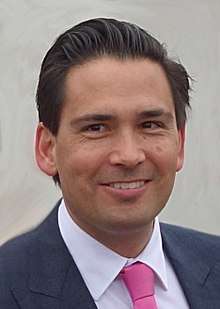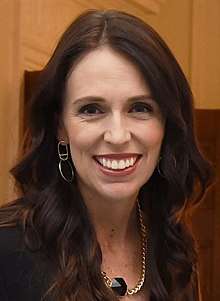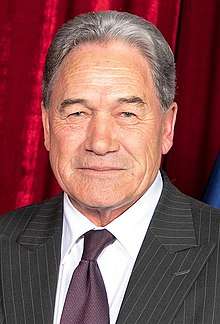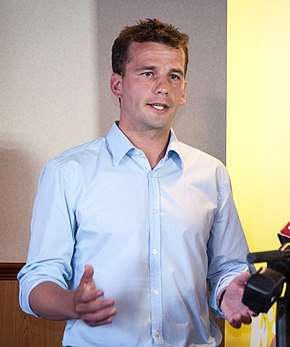Next New Zealand general election
|
| ||||||||||||||||||||||||||||||||||||||||||||||||||||||
| ||||||||||||||||||||||||||||||||||||||||||||||||||||||
All 120 seats (plus any overhang) in the House of Representatives 61 seats needed for a majority | ||||||||||||||||||||||||||||||||||||||||||||||||||||||
|---|---|---|---|---|---|---|---|---|---|---|---|---|---|---|---|---|---|---|---|---|---|---|---|---|---|---|---|---|---|---|---|---|---|---|---|---|---|---|---|---|---|---|---|---|---|---|---|---|---|---|---|---|---|---|
| Opinion polls | ||||||||||||||||||||||||||||||||||||||||||||||||||||||
| ||||||||||||||||||||||||||||||||||||||||||||||||||||||
| ||||||||||||||||||||||||||||||||||||||||||||||||||||||
The next New Zealand general election will be held after the currently elected 52nd New Zealand Parliament is dissolved or expires. The current Parliament was elected on Saturday, 23 September 2017. The last possible date for the next general election to be held is Saturday, 21 November 2020.
Voters will elect 120 members to the House of Representatives under New Zealand's mixed-member proportional (MMP) voting system, a proportional representation system in which 71 members are elected from single-member electorates and 49 members are elected from closed party lists.
After the previous election, the centre-left Labour Party, led by Prime Minister Jacinda Ardern, formed a minority coalition government with the New Zealand First party, with confidence and supply from the Green Party. The main opponent to the Labour–NZ First government is the centre-right National Party, led by Simon Bridges. The single-member ACT Party is the sole other party in Parliament.
Background
The final results of the 2017 election gave National 56 seats, while Labour and the Greens combined had 54 seats. New Zealand First won 9 seats, which put them in the position to give either National or Labour the 61 seats needed form a government. On 19 October 2017, Winston Peters, leader of New Zealand First, announced that he would form a coalition government with Labour.[1] On the same day, James Shaw, leader of the Green Party, announced that his party would give confidence and supply to a Labour-NZ First government.[2] The result of the election saw the Labour Party regain power after nine years in opposition, as well as the end of the Fifth National Government which had been in power for three terms (2008–2017). The 2017 election also saw the first party under MMP in New Zealand to lead a government without commanding the plurality of the party vote.
Current standings
| Party affiliation | Seats | ||
|---|---|---|---|
| 2017 election | Current | ||
| LabourCoa | 46 | 46 | |
| NZ FirstCoa | 9 | 9 | |
| GreenCS | 8 | 8 | |
| Government total | 63 | 63 | |
| National | 56 | 55 | |
| ACT | 1 | 1 | |
| Independent | 0 | 1 | |
| Opposition total | 57 | 57 | |
| Total |
120 | 120 | |
| Working Government majority | 6 | 6 | |
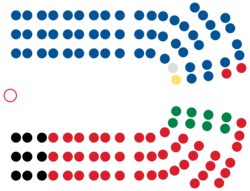 | |||
| Current seating plan of Parliament | |||
Electoral system
New Zealand uses the mixed-member proportional (MMP) voting system to elect the House of Representatives. Each voter gets two votes, one for a political party (the party vote) and one for a local candidate (the electorate vote). Political parties which meet the threshold (5% of the party vote or one electorate seat) receive seats in the House in proportion to the percentage of the party vote they receive. 71 of the 120 seats are filled by the MPs elected from the electorates, with the winner in each electorate determined by the first past the post method (i.e. most votes wins). The remaining 49 seats are filled by candidates from each party's closed party list. If a party wins more electorates than seats it is entitled to under the party vote, an overhang results; in this case, the House will add extra seats to cover the overhang.
The political party or party bloc with the majority of the seats in the House forms the Government. Since the introduction of MMP in 1996, no party has won enough votes to win an outright majority of seats. As a result, parties must negotiate with other parties to form a coalition government or a minority government.
Electorate boundaries
Electorate boundaries for the next election are due to be redrawn in 2019, after the 2018 census and Māori electoral option. This means that unless a snap election is called before 2019, the next general election will be the first to use boundaries based on the 2018 census.
The number of South Island general electorates is fixed at 16,[3] with the number of North Island general electorates and Māori electorates increasing or decreasing in proportion. For the 2014 and 2017 elections, there were 48 North Island general electorates and seven Māori electorates.
Election date
Unless an early election is called or the election date is set to circumvent holding a by-election, a general election is held every three years. The last election was held on Saturday, 23 September 2017.
The Governor-General must issue writs for an election within seven days of the expiration or dissolution of the current Parliament. Under section 17 of the Constitution Act 1986, Parliament expires three years "from the day fixed for the return of the writs issued for the last preceding general election of members of the House of Representatives, and no longer." The writs for the 2017 election were returned on Thursday, 12 October 2017. As a result, the 52nd Parliament must dissolve no later than Monday, 12 October 2020. Consequently, the last day for issuance of writs of election is Monday, 19 October 2020. The writs must be returned within 50 days of their issuance (save for any judicial recount or death of a candidate), which will be Monday, 7 December 2020.[4] Because polling day must be on a Saturday,[4] and two weeks is generally required for the counting of special votes, the last possible date for the next general election is Saturday, 21 November 2020.
The previous two general elections (2014 and 2017) were held on the second-to-last Saturday in September. If this trend were to continue, the next election would be held on 19 September 2020. By coincidence, this date is the 127th anniversary of the Electoral Act 1893, which granted women the right to vote in New Zealand.
Potential parties and candidates
Political parties registered with the Electoral Commission can contest the general election as a party. To register, parties must have at least 500 financial members, an auditor, and an appropriate party name.[5] A registered party may submit a party list to contest the party vote, and can have a party campaign expenses limit in addition to limits on individual candidates' campaigns. Unregistered parties and independents can contest the electorate vote only.
Since the 2017 general election, three parties have formally been de-registered. On 14 November 2017, United Future leader Damian Light announced that his party would be dissolved, and thus not contest any future elections.[6] The Ban 1080 Party was deregistered on 28 February 2018 at the party's request.[7] The Internet Party was deregistered on 12 June 2018 because its membership had dropped below the 500 required for registration.[8]
The Opportunities Party announced on 9 July 2018 that the party was to be deregistered following its board's decision to not contest any future elections.[9] The decision was reverted on 20 August 2018 reportedly due to an influx of supporters asking the party to continue.[10]
As of 14 June 2018, the following parties are registered to contest the general election:[11]
| Party | Leader(s) | Founded | Ideology | 2017 election | ||
|---|---|---|---|---|---|---|
| Party vote | Seats | |||||
| National | Simon Bridges | 1936 | Liberal conservatism | 44.45% | 56 | |
| Labour | Jacinda Ardern | 1916 | Social democracy | 36.89% | 46 | |
| NZ First | Winston Peters | 1993 | Conservatism, Nationalism, Populism | 7.20% | 9 | |
| Green | James Shaw / Marama Davidson | 1990 | Green politics | 6.27% | 8 | |
| ACT | David Seymour | 1994 | Classical liberalism, Libertarianism | 0.50% | 1 | |
| Opportunities | Geoff Simmons | 2016 | Radical centrism, Environmentalism | 2.44% | – | |
| Māori | Te Ururoa Flavell / Marama Fox | 2004 | Indigenous rights | 1.18% | – | |
| Legalise Cannabis | Jeff Lye | 1996 | Cannabis legalisation | 0.31% | – | |
| Conservative | Leighton Baker | 2011 | Conservatism, Fiscal conservatism, Social conservatism | 0.24% | – | |
| Mana | Hone Harawira | 2011 | Tino rangatiratanga, Māori rights | 0.14% | – | |
| People's Party | Roshan Nauhria | 2015 | Minority rights, Cultural rights | 0.07% | – | |
| Outdoors | David Haynes / Alan Simmons | 2015 | Environmentalism | 0.06% | – | |
| Democrats | Stephnie de Ruyter | 1985 | Social Credit, Economic democracy, Left-wing nationalism | 0.03% | – | |
Opinion polls
Various organisations have commissioned opinion polling for the next general election. Three main polling organisations regularly sample the electorates' opinions: MediaWorks New Zealand, Roy Morgan Research, and Television New Zealand.

Seat projections
The use of mixed-member proportional representation allows ready conversion of a party's support into a party vote percentage and therefore a number of seats in Parliament. Projections generally assume no changes to electorate seats each party holds (ACT retains Epsom, Labour retains Waiariki, etc.) unless there is a specific reason to assume change. For example, after Peter Dunne announced his retirement, projections stopped assuming United Future would retain Ōhāriu. Other parties that do not pass the 5% threshold are assumed to not to win an electorate and therefore gain no seats.
Radio New Zealand takes a "poll of polls" average to produce their forecast. The New Zealand Herald bases theirs on a predictive model incorporating poll data as well as past election results and past poll accuracy.[12] Newshub and 1 News and produce projections based on their own polls only.
When determining the scenarios for the overall result, the minimum parties necessary to form majority governments are listed (provided parties have indicated openness to working together). Actual governments formed may include other parties beyond the minimum required for a majority. This happened after the 2014 election, when National only needed one seat from another party to reach a 61-seat majority, but they formed a 64-seat government with Māori, ACT and United Future.
| Party | 2017 election result | Roy Morgan[13] 30 Oct – 12 Nov 2017 poll |
1 News Colmar Brunton[14] 28 Jul – 1 Aug 2018 poll |
Radio NZ[15] 5 Jun 2018 poll of polls |
Newshub Reid Research[16] 17 – 24 May 2018 poll | |
|---|---|---|---|---|---|---|
| National | 56 | 51 | 55 | 57 | 58 | |
| Labour | 46 | 49 | 51 | 54 | 55 | |
| NZ First | 9 | 6 | 6 | 0 | 0 | |
| Green | 8 | 13 | 7 | 8 | 8 | |
| ACT | 1 | 1 | 1 | 1 | 1* | |
| Seats in Parliament | 120 | 120 | 120 | 120 | 122 | |
| Overall result (majority) | National–NZ First (65) | Labour–Green (62) | Labour–Green–NZ First (64) | Labour–Green (62) | Labour–Green (63) | |
| Labour–Green–NZ First (63) | ||||||
| Note: Forecasted seats are currently calculated using the Electoral Commission's MMP seat allocation calculator, based on polling results. | ||||||
- * indicates an overhang seat
Notes
- ^Coa New Zealand First announced a coalition agreement with the Labour Party on 19 October 2017.
- ^CS The Green Party entered into a confidence and supply agreement with the Labour Party on the same day as the coalition was announced.
References
- ↑ Chapman, Grant (19 October 2017). "Full video: NZ First leader Winston Peters announces next Government". Newshub. Retrieved 19 October 2017.
- ↑ Hurley, Emma (19 October 2017). "An 'historic moment' for the Green Party – James Shaw". Newshub. Retrieved 19 October 2017.
- ↑ Electoral Act 1993, section 35(3)(a).
- 1 2 "Electoral Act 1993, Sec. 139". Legislation.co.nz. 17 August 2011. Archived from the original on 29 June 2016. Retrieved 22 October 2017.
- ↑ Electoral Act 1993, section 63.
- ↑ "UnitedFuture proud of it's [sic] history, but all good things must end". Damian Light. Retrieved 14 November 2017.
- ↑ https://www.elections.org.nz/news-media/amendments-register-political-parties-28-february-2018
- ↑ "CANCELLATION OF PARTY REGISTRATION". New Zealand Electoral Commission.
- ↑ "Gareth Morgan's The Opportunities Party is over". Stuff. Retrieved 9 July 2018.
- ↑ "The Opportunities Party decides it isn't riding off into the sunset". Stuff. Retrieved 20 August 2018.
- ↑ "Register of Political Parties". Electoral Commission. Retrieved 28 February 2018.
- ↑ "Herald election forecasts explained". NZ Herald.
- ↑ http://www.roymorgan.com/findings/7419-roy-morgan-new-zealand-voting-intention-november-2017-201711220740
- ↑ https://www.tvnz.co.nz/one-news/new-zealand/simon-bridges-still-struggling-cut-through-voters-latest-1-news-colmar-brunton-poll-shows 1 News Colmar Brunton
- ↑ https://www.radionz.co.nz/news/political/358890/no-budget-lift-for-labour-in-polls-but-support-for-pm-still-strong
- ↑ http://www.newshub.co.nz/home/politics/2018/05/simon-bridges-failing-to-connect-with-voters-newshub-poll.html
